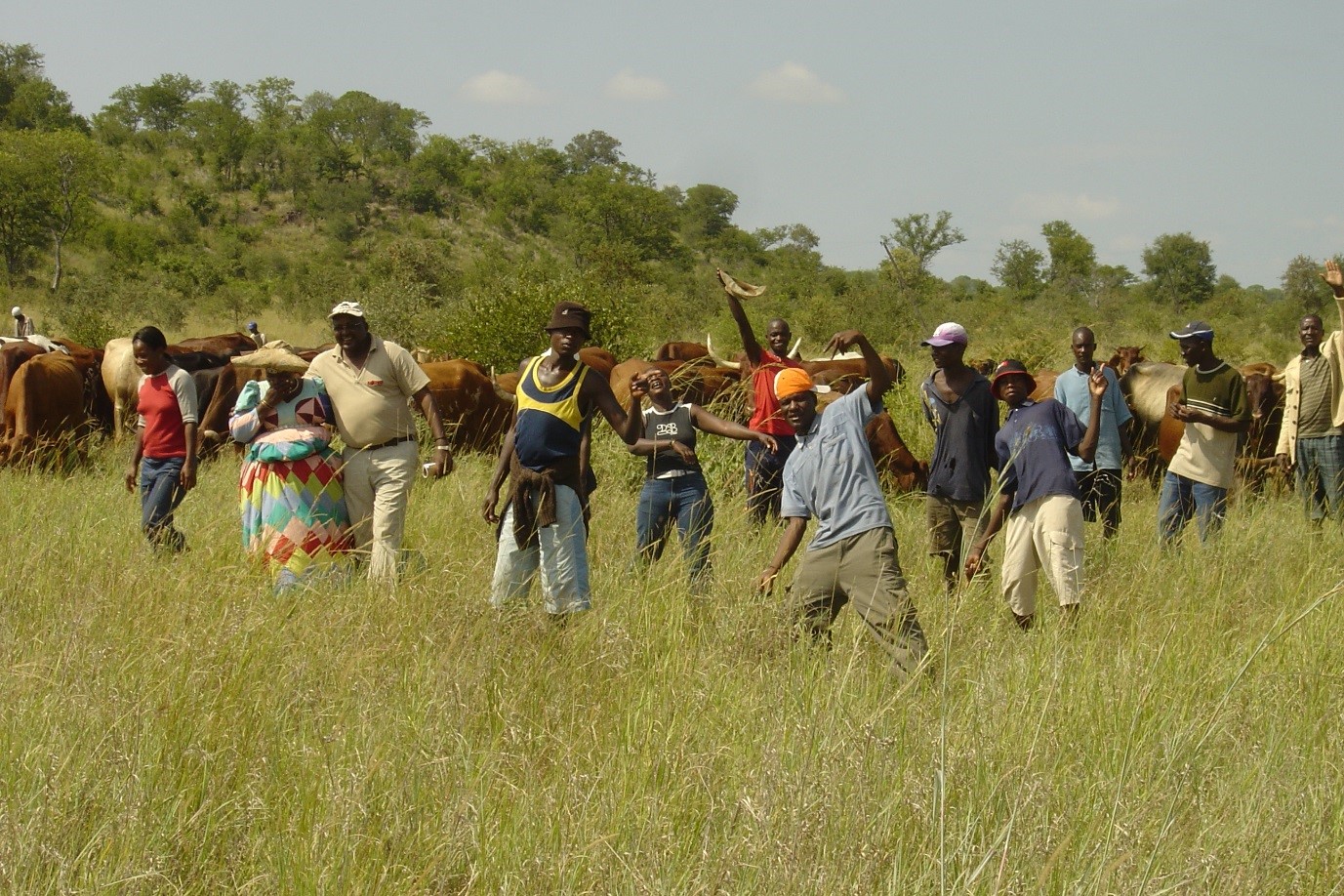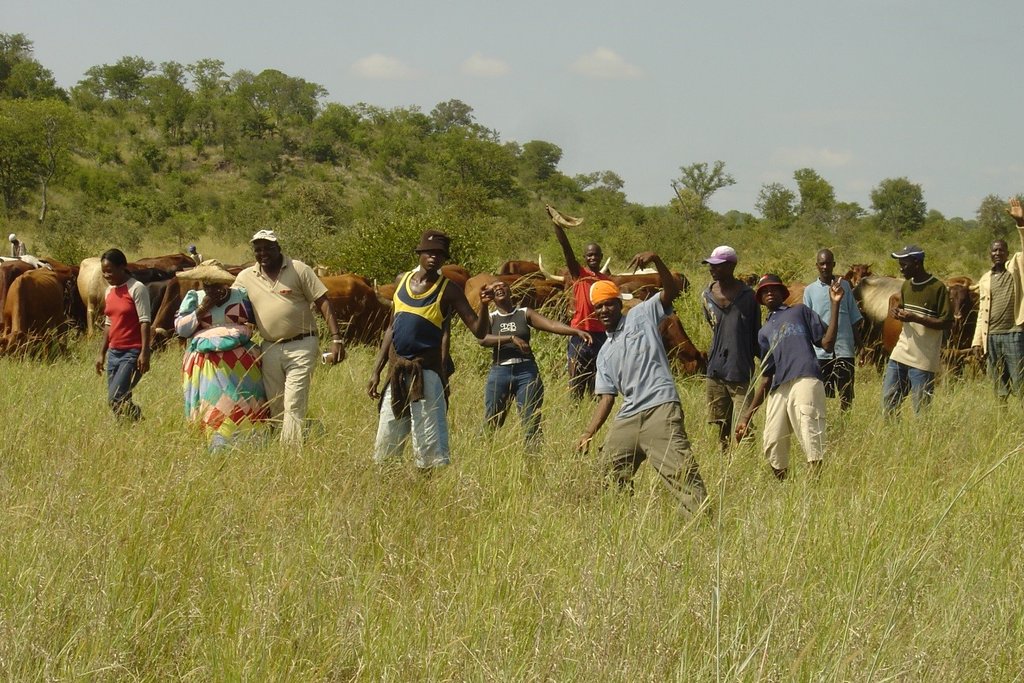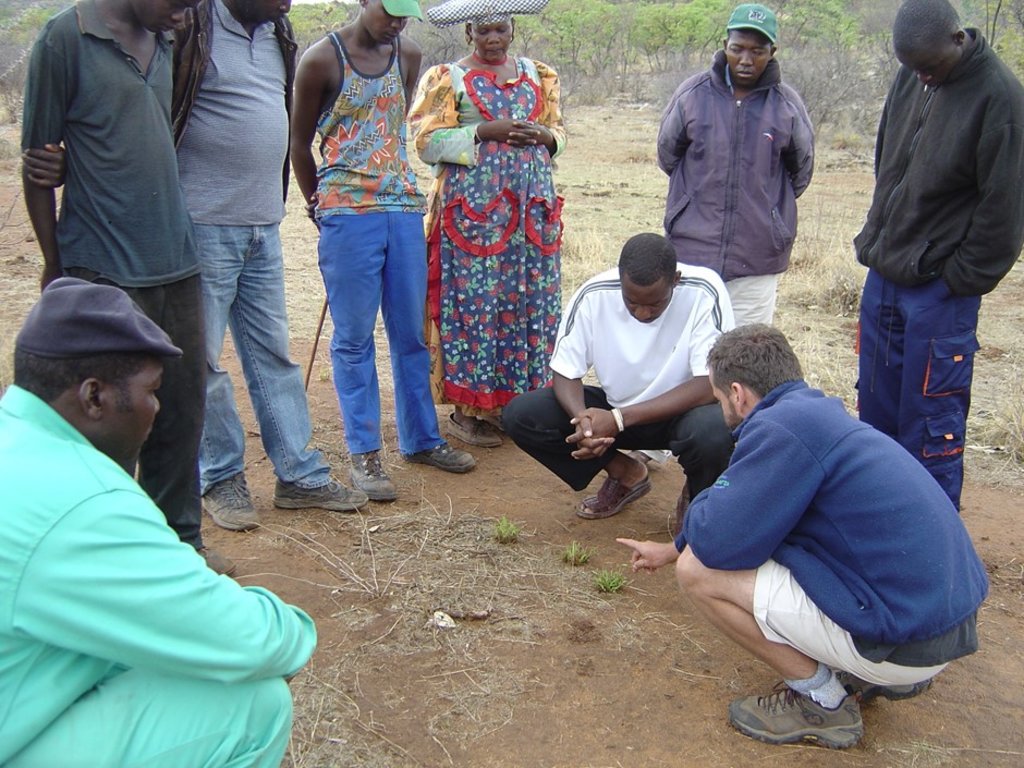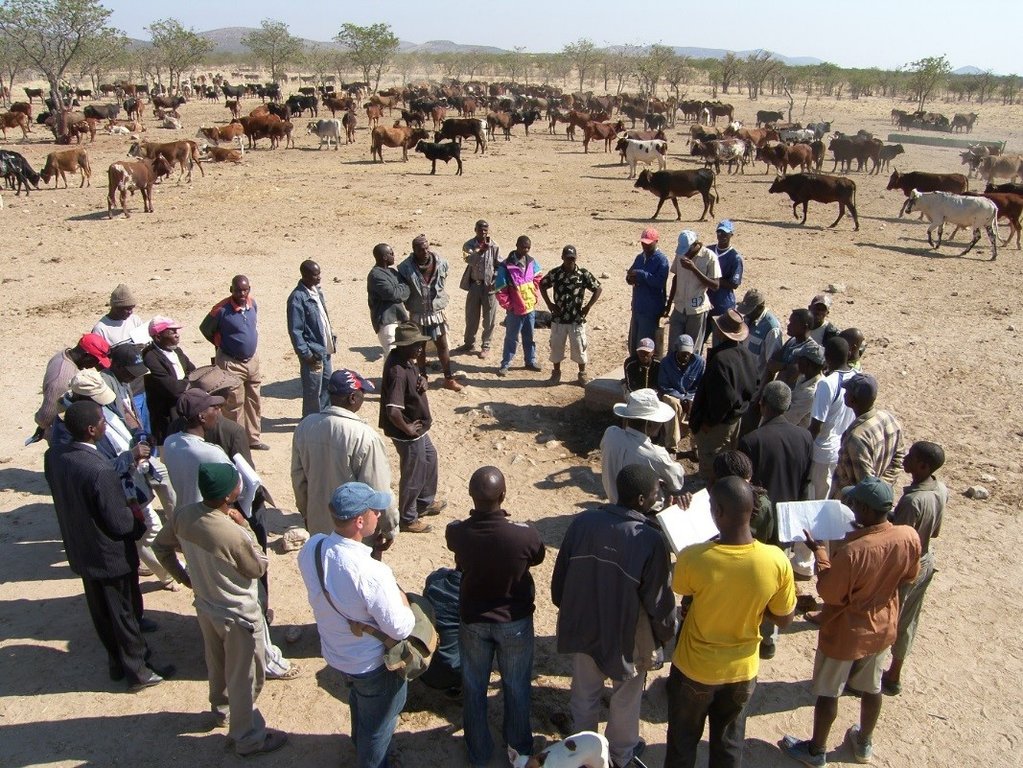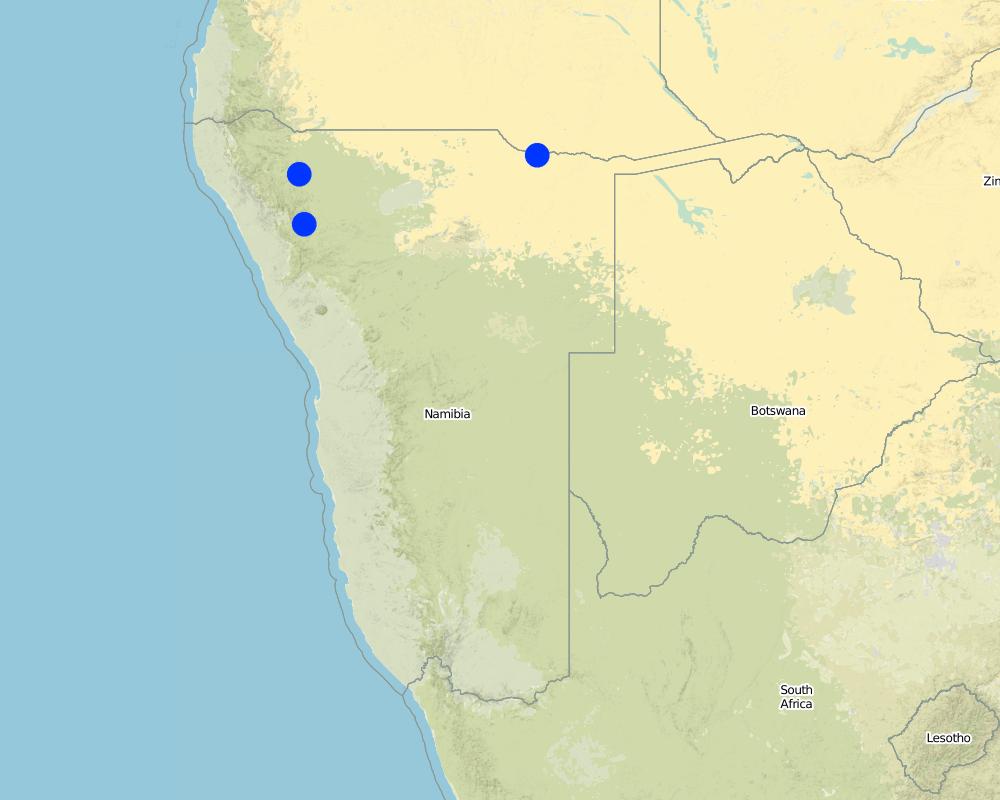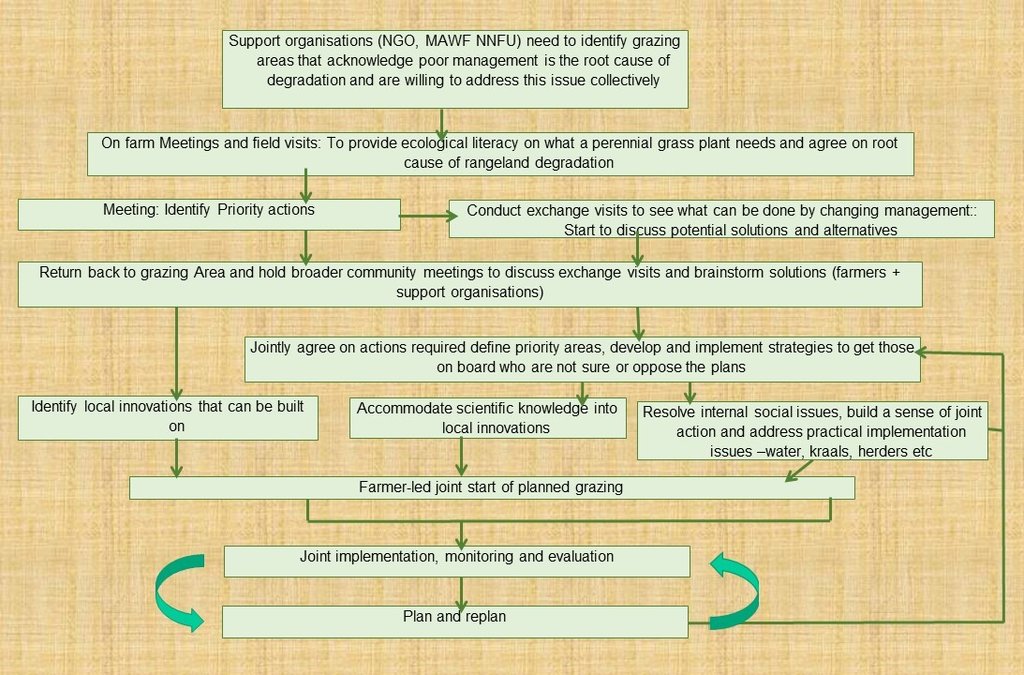Commuity grazing management [纳米比亚]
- 创建:
- 更新:
- 编制者: Ibo Zimmermann
- 编辑者: –
- 审查者: Rima Mekdaschi Studer
Omarisiro wovinamuinjo motjimbumba
approaches_3050 - 纳米比亚
查看章节
全部展开 全部收起1. 一般信息
1.2 参与方法评估和文件编制的资源人员和机构的联系方式
土地使用者:
有助于对方法进行记录/评估的项目名称(如相关)
Southern African Science Service Centre for climate change and Adaptive Land management (SASSCAL)有助于对方法进行记录/评估的机构名称(如相关)
Conservation Agriculture Namibia (Conservation Agriculture Namibia) - 纳米比亚有助于对方法进行记录/评估的机构名称(如相关)
Zakumuka Producers Co-operative (Zakumuka Producers Co-operative) - 纳米比亚1.3 关于使用通过WOCAT记录的数据的条件
(现场)数据是什么时候汇编的?:
2017
编制者和关键资源人员接受有关使用通过WOCAT记录数据的条件。:
是
1.4 SLM技术问卷的参考
2. SLM方法的描述
2.1 该方法的简要说明
Agreement among community members to jointly manage their communal grazing area by combining their livestock into a single herd. The herd is managed and moved according to an agreed growing season plan that provides sufficient recovery for perennial grasses, and a non-growing season plan to graze in a way that prepares soil and plants for the next season. Regenerating rangeland productivity and well-being is the goal.
2.2 该方法的详细说明
该方法的详细说明:
The approach is a partnership between an NGO, Ministry of Land Reform (MLR), Ministry of Agriculture , Water and Forestry (MAWF), the National Farmers Union (NNFU), traditional authorities, and regional and local government. The NGO raises awareness among the community about the damage caused to the rangeland by individual herds of livestock grazing continuously – and to appreciate the benefits of planned grazing. Livestock owners invite facilitators to compare the current state of their land with that of the past. The reasons for the decline are investigated. Once livestock owners understand that perennial grasses need recovery, they soon conclude that their management caused the loss of perennial grass and the increase in bare ground. At this point, the aim of the approach can be pursued. This is to regenerate rangeland productivity in the communal grazing area and thereby support higher livestock production. This in turn supports livelihoods.
If motivation to apply planned grazing exists among the community members, then their right to claim common property ownership needs to be established. In pioneering communities this requires at least 10 village level livestock owner meetings to decide on modalities of planned grazing. These meetings continue after planned grazing has started to deal with ongoing planning, animal production and marketing. Exposure visits to areas with successful grazing management help. On return frequent follow-up meetings, facilitated by the NGO and the MAWF, can resolve local issues, including traditional taboos, such as combining animals in one kraal, and whose bulls should be kept and managed.
Boundaries with neighbouring communities need to be mapped, recognised and respected by all. In case of grass poaching, the offenders must to be swiftly dealt with, preferably through customary law. A grazing plan needs to be agreed by all livestock owners, and endorsed by the local Traditional Authority. The grazing area (GA) is then mapped, while six herders, one of whom is their manager, are appointed from among the community though common agreement. Each livestock owner pays a portion of the herding and management cost pro-rata based on the number of his livestock. At night the cattle are separated and kraaled near the homesteads of their owners. In the morning, the herders collect cattle from the kraals. Different portions of the grazing area are grazed daily and only returned to when the grass has replenished its root reserves - some months later.
The process started at Erora in 2004, facilitated by the NGO, Integrated Rural Development and Nature Conservation (IRDNC). Implementation began in 2006, combining approximately 1200 cattle from 12 households. Livestock owners noticed a higher density of annual grasses after the first season; dramatic improvement in soil cover after three years with emergence of grass seedlings where none had grown for decades. Then after another three years, perennial grasses returned with increased biodiversity in many parts. However, when the extended drought started in 2011, planned grazing was interrupted and gullies expanded, down which rainwater flowed, dehydrating the rangelands. The drought lasted for five years, and the planned grazing was temporarily discontinued in 2013. During this period, rehabilitation work included constructing bush filters along key gullies: facilitation was taken over by another NGO, Conservation Agriculture Namibia (CAN). After successive years of severe drought, cattle became too weak to be rounded up, and in 2014 the community members decided to revert to keeping cattle near their homesteads. This was intended to be temporary but cattle only gained sufficient strength in 2017. The communal grazing management approach was extended to other villages in 2012, despite the drought. New boreholes were drilled and installed to facilitate improved planned grazing.
2.3 该方法的照片
2.4 该方法的视频
注释、简短说明:
www.youtube.com/watch?v=xNyFkDUH6MQ
This video is from a DVD created by the Integrated Rural Development and Nature Conservation (IRDNC), a Namibian NGO and co-sponsored by the Namibian Ministry of Agriculture and the Namibian National Farmers Union. The video documents the development of a rangeland program focused on Holistic Management, spearheaded by Colin Nott, a Holistic Management educator.
日期:
2007
位置:
Erora, Namibia
摄影师的名字:
Andrew Botelle
注释、简短说明:
www.youtube.com/watch?v=3Ey5v40KtkI
Combined herding to manage communal grazing with the use of stress-free handling of cattle,
日期:
2007
位置:
Erora, Namibia
摄影师的名字:
Andrew Botelle
注释、简短说明:
www.youtube.com/watch?v=6C4V_Cib8ts
Managing water flow to repair gully erosion
日期:
2015
位置:
Namibia
摄影师的名字:
Andrew Botelle
2.5 采用该方法的国家/地区/地点
国家:
纳米比亚
区域/州/省:
Kunene Region
有关地点的进一步说明:
Erora village, 18.32637 South, 14.05912 East
Map
×2.6 该方法的开始和终止日期
注明开始年份:
2004
注释:
Combined herding was discontinued at Erora in 2013 due to extreme drought, which ended in 2016/2017 rainy season, and land users are planning to use reserved grazing, whereby cattle are taken out each day by herders and left there to return on their own to water points. In the meantime, combined herding has already resumed at the Outokotorua grazing area.
2.7 方法的类型
- Science informs the traditional practice
2.8 该方法的主要目的/目标
To regenerate rangeland productivity for supporting livelihoods and improved quality of life.
2.9 推动或妨碍实施本办法所适用的技术的条件
社会/文化/宗教规范和价值观
- 启动
Herding is customary, and the task is now shared among families
- 阻碍
Herding no longer carries the high social status that it had previously.
财务资源和服务的可用性/可得性
- 启动
No bought inputs are required, and fewer herders needed than with many small herds. Also fewer losses from stock theft and predators
机构设置
- 启动
A grazing area committee was established with support of livestock owners
- 阻碍
The grazing area committee is not legally recognised
参与者的的协作/协调
- 启动
Partnership approach with MLR, Ministry of Agriculture, Water and Forestry (MAWF) the NNFU, traditional authorities and regional and local government.
- 阻碍
Resolution of local issues to apply grazing plans needs to be resolved
法律框架(土地使用权、土地和水使用权)
- 启动
National Policy and strategy is in place which supports sound management principles
- 阻碍
Grass poaching by neighbouring communities is not adequately dealt with by the law
政策
- 启动
The approach is based upon the Namibia National Rangeland Management Policy and Strategy
- 阻碍
Common property rights are insufficiently promoted
土地治理(决策、实施和执行)
- 阻碍
Lack of integration of different scales of management between conservancies at large scales and grazing areas at smaller scale is required
了解SLM,获得技术支持
- 启动
The awareness exists among participating livestock owners and stakeholders
市场(购买投入,销售产品)和价格
- 启动
The Namibia National Farmers Union is busy addressing markets north of the veterinary cordon fence, which maintains a zone free of foot-and-mouth disease to the south from where farmers are able to access the lucrative EU market
- 阻碍
During drought the drop in prices from sudden increase in supply, results in inability of farmers to sell livestock when sudden shortage of forage occurs
工作量、人力资源可用性
- 启动
Fewer herders are required for one large herd than for many small herds
- 阻碍
The role of herders as rangeland managers lacks status and is not adequately appreciated, resulting in high turnover of trained herders and their manager.
其他
- 阻碍
One large livestock owner at a given place can hinder efforts of the majority to improve rangeland management
3. 相关利益相关者的参与和角色
3.1 该方法涉及的利益相关者及其职责
- 当地土地使用者/当地社区
Communities of Erora, Outokotorua and Nsindi
To organise, plan and implement
- 社区组织
Grazing Committee
Oversee day to day implementation
- SLM专家/农业顾问
Integrated Rural Development and Nature Conservation (IRDNC), then Conservation Agriculture Namibia (CAN) and Namibia National Farmers Union (NNFU)
To facilitate adoption and upscaling of the approach
- 研究人员
United States Department of Agriculture (USDA)
To assess rangeland condition changes
- NGO
First IRDNC, then CAN
To facilitate the approach
- 私营部门
Zakumuka Producers Cooperative
To organise auctions for sale of livestock
- 地方政府
Traditional authorities
To support and enable agreed rules
- 国家政府(规划者、决策者)
Namibian Ministries of Lands & Agriculture
Assist with facilitation and support
- Farmers union
Namibia National Farmers Union
Enabling policy and legislation
如果涉及多个利益相关者,请注明领导机构:
Integrated Rural Development and Nature Conservation (IRDNC), taken over in 2014 by Conservation Agriculture Namibia (CAN)
3.2 当地土地使用者/当地社区参与该方法的不同阶段
| 当地土地使用者/当地社区的参与 | 指定参与人员并描述活动 | |
|---|---|---|
| 启动/动机 | 互动 | The community, with focus on livestock owners, youth, women and herders, under facilitation by NGO by conducting exchange visits to neighbouring countries |
| 计划 | 互动 | Feedback was given to communities by participants of exchange visits, grazing committees appointed to contextualise and re-plan for the way forward under guidance of NGO, Ministry of Agriculture, Water and Forestry (MAWF) and Namibia National Farmers Union (NNFU) |
| 实施 | 互动 | The grazing committee, livestock owners and herders carry out the grazing plan with support of NGO, MAWF and NNFU |
| 监测/评估 | 互动 | The grazing committee and livestock owners constantly plan and replan and evaluate results on livestock performance and rangeland and daily check where livestock have grazed and where they will graze next and feed results into re-planning. Annual assessments of forage in May, to determine stocking rate. |
| external assessment of data | 外部支持 | External assessment by researchers of data gathered by USDA through Innovations for Poverty Action (IPA) |
3.3 流程图(如可用)
3.4 有关SLM技术选择的决策
具体说明谁有权决定选择要实施的技术:
- 主要是土地使用者,由SLM专家提供支持
解释:
After exposure to sound management techniques and on farm identification and agreement on the root cause of the degradation – the farmers themselves decide if they will continue or not.
明确做出决策的依据:
- 对充分记录的SLM知识进行评估(基于证据的决策)
- 个人经验和意见(无记录)
4. 技术支持、能力建设和知识管理
4.1 能力建设/培训
是否为土地使用者/其他利益相关者提供培训?:
是
明确受训人员:
- 土地使用者
- 现场工作人员/顾问
- Ministry of Agriculture, Namibia National Farmers Union.
如果相关,请说明性别、年龄、地位、种族等。:
Inclusion of youth, women and herders.
培训形式:
- 在职
- 农民对农民
- 公开会议
涵盖的主题:
On farm(s) exploration of root cause of degradation based on how it was in the past and how it looks now and why this change has happened.
注释:
A number of issues including: Rangeland management, focussing on the needs of grass plants and soil. Needs of herders, people and stakeholders and how these various needs can be met. Institutional support for grazing committee, focussing on budgeting and financial management.
4.2 咨询服务
土地使用者有权使用咨询服务吗?:
是
指明是否提供了咨询服务:
- 在土地使用者的土地上
- Visits to successful farmers
说明/注释:
Mostly through exchange visits, community meetings, on farm excursions and on-the-job training.
4.3 机构强化(组织发展)
是否通过这种方法建立或加强了机构?:
- 是,非常
具体说明机构的强化或建立程度:
- 本地
- 区域
说明机构、角色和职责、成员等。:
Grazing Committee guides and implements the grazing plans and support organisations including Ministry of Agriculture, Namibia National Farmers Union and NGOs provide support and advice.
具体说明支持类型:
- 能力建设/培训
- 设备
提供进一步细节:
Exchange visits, facilitation of meetings and on-the-job training. Drilling and equipping of boreholes. Redesign of water supply for livestock and combined kraaling system.
4.4 监测和评估
监测和评估是该方法的一部分吗?:
是
注释:
To support decision making
若是,该文件是否用于监测和评估?:
否
4.5 研究
研究是该方法的一部分吗?
是
明确话题:
- 社会学
- 经济/市场营销
- 生态学
提供进一步的细节,并指出是谁做的研究:
USDA/IPA came to evaluate rangelands and consult key stakeholders
5. 融资和外部物质支持
5.1 该方法中SLM组成部分的年度预算
说明该方法中SLM部分的年度预算,单位为美元:
10000.00
如果不知道准确的年度预算,请给出一个范围:
- 10,000-100,000
注释(例如主要的资助来源/主要捐助者):
Major donor to initiate the project was Enagelica Entwikelins Diens (EED), through IRDNC and later funding came from the Millenium Challenge Account (MCA), the EU and now the Finnish Embassy through CAN. Cost is per grazing area for local level field facilitation.
5.2 为土地使用者提供财政/物质支援
土地使用者是否获得实施该技术的财政/物质支持?:
是
如果是,请具体说明支持的类型、条件和提供者:
Upgrades of boreholes, drilling and equipping of new boreholes that are elephant-proof and construction of lion-proof kraaling was funded through the NGO.
5.3 对特定投入的补贴(包括劳动力)
- 劳动力
| 程度如何 | 对补贴做出具体说明 |
|---|---|
| 部分融资 | Part payment to herders 2004-2007 in Erora only |
- 其它
| 其它(具体说明) | 程度如何 | 对补贴做出具体说明 |
|---|---|---|
| Boreholes and kraals | 部分融资 | Erora upgrade USD 10 000, second solar borehole half funded by community USD 10 000. Lion proof kraal funded by Africat – USD 2 000 |
如果土地使用者的劳动力是一项重要的投入,那么是不是:
- 以现金支付
注释:
Only for first four years at one of the villages to enable proof of concept to be established.
5.4 信用
是否根据SLM活动的方法给予信用值?:
否
5.5 其它激励或手段
是否有其他激励措施或工具用于促进SLM技术的实施?:
否
6. 影响分析和结论性陈述
6.1 方法的影响
该方法是否有助于当地土地使用者,提高利益相关者的参与度?:
- 否
- 是,很少
- 是,中等
- 是,支持力度很大
Through the whole approach.
这种方法是否有助于基于证据的决策?:
- 否
- 是,很少
- 是,中等
- 是,支持力度很大
Through observations by herders and livestock owners.
该方法是否帮助土地使用者实施和维护SLM技术?:
- 否
- 是,很少
- 是,中等
- 是,支持力度很大
Combined herding through planned grazing.
该方法是否提高了SLM的协调性和成本效益?:
- 否
- 是,很少
- 是,中等
- 是,支持力度很大
Key stakeholders are all involved.
该方法是否调动/改善了使用财务资源实施SLM的途径?:
- 否
- 是,很少
- 是,中等
- 是,支持力度很大
该方法是否提高了土地使用者实施土地管理的知识和能力?:
- 否
- 是,很少
- 是,中等
- 是,支持力度很大
Training provided the skills to self organise and implement activities based upon identification of root cause of land degradation.
该方法是否提高了其他利益相关者的知识和能力?:
- 否
- 是,很少
- 是,中等
- 是,支持力度很大
Ministries of Agriculture and Lands.
该方法是否建立/加强了机构、利益相关者之间的合作?:
- 否
- 是,很少
- 是,中等
- 是,支持力度很大
Key stakeholders are all collaborating, since the solution to rangelands cuts across various sectors.
该方法是否缓解了冲突?:
- 否
- 是,很少
- 是,中等
- 是,支持力度很大
Reinstated sense of community
该方法是否有助于社会和经济弱势群体?:
- 否
- 是,很少
- 是,中等
- 是,支持力度很大
Women-headed households now have their livestock herded communally.
该方法是否改善了性别平等并赋予女性权力?:
- 否
- 是,很少
- 是,中等
- 是,支持力度很大
Women-headed households now have their livestock herded communally.
该方法是否鼓励年轻人/下一代土地使用者参与SLM?:
- 否
- 是,很少
- 是,中等
- 是,支持力度很大
Herders are mainly youth and young livestock owners, who appreciate improved rangeland and are now willing to remain.
该方法是否改善了阻碍SLM技术实施的土地使用权/用户权问题?:
- 否
- 是,很少
- 是,中等
- 是,支持力度很大
The willingness to address appropriate land rights may initiate resolution of land issues.
该方法是否改善了粮食安全/改善了营养?:
- 否
- 是,很少
- 是,中等
- 是,支持力度很大
Much during good rains and little during drought.
该方法是否改善了市场准入?:
- 否
- 是,很少
- 是,中等
- 是,支持力度很大
该方法是否改善了供水和卫生条件?:
- 否
- 是,很少
- 是,中等
- 是,支持力度很大
Access to borehole water was provided.
该方法是否带来了更可持续的能源使用?:
- 否
- 是,很少
- 是,中等
- 是,支持力度很大
Solar installations were installed or replaced diesel where possible for pumping of water.
该方法是否提高了土地使用者适应气候变化/极端情况和减轻气候相关灾害的能力?:
- 否
- 是,很少
- 是,中等
- 是,支持力度很大
Improved grass growth in good rain years and improved survival in drought.
该方法是否会带来就业、收入机会?:
- 否
- 是,很少
- 是,中等
- 是,支持力度很大
Herders and managers were appointed.
6.2 土地使用者实施SLM的主要动机
- 增加生产
Increased grass, higher calving and reduced mortalities.
- 增加利润(能力),提高成本效益比
Increased grass, higher calving and reduced mortalities.
- 减少土地退化
Changing unsustainable practices for improved resource base.
- 减少工作量
Fewer herders needed.
- 声望、社会压力/社会凝聚
Social cohesion to implement joint management.
- 环境意识
To support the future of livestock in their area.
6.3 方法活动的可持续性
土地使用者能否维持通过该方法实施的措施(无外部支持的情况下)?:
- 是
若是,请说明如何维持:
They mobilise themselves, appoint herders, do the implementation, do the planning jointly and, and only asking for some technical support.
6.4 该方法的长处/优点
| 土地使用者眼中的长处/优势/机会 |
|---|
| By caring for the rangeland, farmers will have grass all year round and minimise effects of drought. |
| 编制者或其他关键资源人员认为的长处/优势/机会 |
|---|
| It has proven to improve the resource base if applied properly. |
| It is viable and upscalable. |
| It has diverse benefits for the land user, including economic, social and environmental. |
6.5 该方法的弱点/缺点以及克服它们的方法
| 土地使用者认为的弱点/缺点/风险 | 如何克服它们? |
|---|---|
| If a new water point needs to be developed, then funds will be required | Convince land users that by selling one or a few cattle to invest in a new water point, they will realise the returns from increased productivity within a few years. |
| 编制者或其他关键资源人员认为的弱点/缺点/风险 | 如何克服它们? |
|---|---|
| The herding is hard work, the status of herders is perceived to be low and they are poorly compensated. |
Convince livestock owners that they can adequately afford to compensate the herders. Start national and regional vocational training in herding, grazing management, low-stress handling, animal health, rangeland management, water management and financial and farm management. |
7. 参考和链接
7.1 方法/信息来源
- 实地考察、实地调查
- 与土地使用者的访谈
- 与SLM专业人员/专家的访谈
7.2 参考可用出版物
标题、作者、年份、ISBN:
Global case studies of grazing in nature’s image, Jim Howell, 2008, 1-4392-1610-X
可以从哪里获得?成本如何?
www.booksuge.com
7.3 链接到网络上可用的相关信息
标题/说明:
Community based rangeland and livestock management
URL:
https://rmportal.net/groups/cbrlm/cbrlm-for-review/namibia-community-based-rangeland-livestock-management-cbrlm-2nd-edition/view
链接和模块
全部展开 全部收起链接
无链接
模块
无模块


